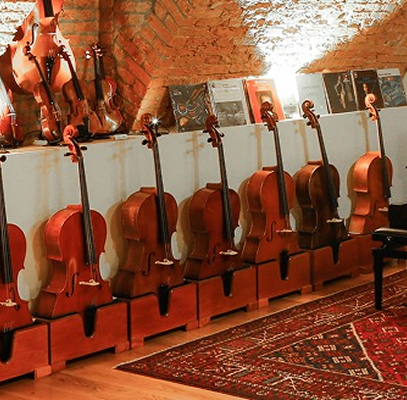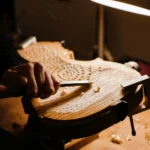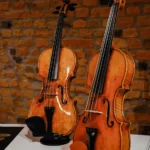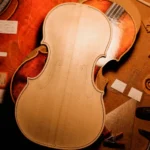Violin Craftsmanship: Understanding the Art Behind the Sound
Back to BlogBeyond Playing—Understanding the Instrument
Understanding the Instrument
Musicians are natural explorers of sound, yet few venture beyond performance to appreciate the complexity of violin craftsmanship. The violin, with its elegance and expressive range, is not only a medium for music but also a masterpiece of acoustic engineering and refined artistry. At Amorim Fine Violins, we invite curious musicians to look beyond the strings and delve into the very soul of their instrument, deepening both their appreciation and connection to their violin.
Tonewoods: Where the Sound Begins
Every violin begins with the careful selection of tonewoods, essential for defining its sonic character. The top plate, usually made of spruce, is prized for its unparalleled ability to transmit vibrations with clarity and speed, critical to achieving a resonant and responsive tone.
The back, ribs, and scroll are typically crafted from maple, selected for its structural strength and visually striking flame patterns. At Amorim Fine Violins, these woods are meticulously aged—often for years—before use, ensuring ideal density, resonance, and grain orientation. This process lays the foundation for the instrument’s voice, influencing everything from tonal warmth to projection and responsiveness.
The Scroll and Pegbox: Aesthetic Identity
Among the most iconic features of violin construction is the scroll, a purely decorative yet deeply expressive element. It serves as the luthier’s signature, revealing their school, historical period, and personal technique. For instance, Baroque scrolls differ significantly from modern interpretations, while individual makers add subtle touches in the fluting depth, symmetry, and tightness of the curves.
Adjacent to the scroll, the pegbox often goes unnoticed but plays a crucial role. Its angle and finish directly influence tuning stability and ease of play. Together, the scroll and pegbox contribute to the violin’s visual identity.
Varnish: Beauty That Resonates
The varnish of a violin serves primarily as a protective and aesthetic layer, preserving the wood from environmental damage and enhancing its visual appeal. While traditionally thought to influence the instrument’s vibration and tonal qualities, contemporary research suggests that varnish has minimal, if any, direct effect on the violin’s sound. Its role is essential for conservation and beauty, but the core acoustic performance derives from the craftsmanship, setup, and quality of materials used.
At Amorim Fine Violins, we meticulously study historical varnish formulations, applying them in thin, even layers. This technique preserves the instrument’s integrity while enriching its visual warmth and allure. The varnish becomes a functional, fragile, and beautiful element integral to fine violin craftsmanship.
Inside the Violin: Bass Bar, Blocks, and Linings
Within the seemingly simple body of the violin lies a hidden world of structural and acoustic elements that are vital to its sound and durability. One of the most significant is the bass bar, a wooden strip running beneath the G-string side of the top plate. At Amorim Fine Violins, each of these internal components is shaped and installed with the utmost precision.For musicians, understanding these often-invisible aspects of violin making deepens their appreciation for the instrument’s complexity and the luthier’s craftsmanship.
Bridge and Setup: The Tonal Gatekeeper
The bridge serves as the gateway through which string vibrations enter the body of the violin, making it one of the most critical components in violin setup. Far from being a mere support, the bridge is intricately carved by hand to fit the top plate’s curvature, accommodate the precise string spacing, and optimize the violin’s unique acoustic needs.
Every adjustment—whether thinning the bridge’s wings or altering the arch height—can dramatically influence aspects like clarity, projection, and articulation. This level of customization ensures that each instrument reaches its full tonal potential.
At Amorim Fine Violins, bridge crafting is treated as one of the most personalized aspects of violin craftsmanship. The luthiers apply their deep expertise to tailor each setup, ensuring that the bridge functions harmoniously with the instrument’s design and materials, enabling the musician to express themselves with nuance and confidence.
Playing an Instrument Built with Intention
Behind every note produced by a violin lies a world of intention and artistry. From the careful selection of tonewoods to the intricate carving of the bridge, every aspect of the instrument has been shaped by the hands of a dedicated luthier, guided by centuries of tradition and innovation in violin construction.
At Amorim Fine Violins, we view each instrument as a bridge between craftsmanship and expression. Understanding the anatomy and artistry of one’s violin does not merely enhance appreciation—it profoundly enriches performance.
This article represents just the beginning of a comprehensive exploration into violin craftsmanship. Future parts of this series will delve deeper into topics such as bow construction, neck angles, and comparative analyses of various lutherie traditions. For now, let curiosity continue to guide your ear—and your eye—as you uncover the remarkable complexities behind every beautifully crafted violin.
At Amorim Fine Violins, we are dedicated to the art of violin making, offering custom instruments crafted to the highest standards, as well as expert restoration services. We invite musicians and enthusiasts to explore our collection and experience firsthand the beauty and precision behind every Amorim instrument.
Visit our website to learn more, schedule a consultation, or inquire about our bespoke services. Let us help you find or restore the instrument that will inspire your next musical journey.









